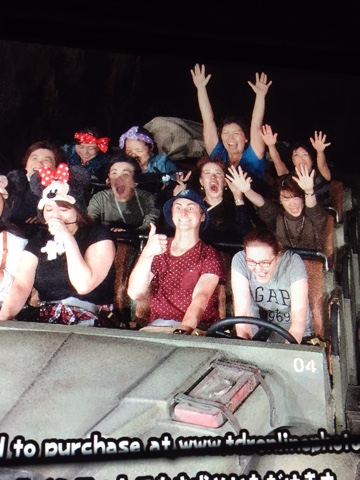Here's a coiuple of shots from their day out at Disney and yes Dan knew what was coming when they took the second photo whilst they were on the Indiana Jones ride from our previous trip.
On the way to the markets we stumbled upon the Tsukiji Hongwanjii Buddist Temple.
 The original Tsukiji Honganji Temple, with an Indian-style exterior, was built in 1617 near Asakusa, but was burnt down in a huge fire that swept through Edo (Tokyo) in 1657. The Temple was then rebuilt on the present site, but destroyed again by the Great Tokyo Earthquake of 1923. The current main building was built in 1934.The main building possesses a distinctive ambience not found in other Japanese temples, due to its variety of architectural styles.
The original Tsukiji Honganji Temple, with an Indian-style exterior, was built in 1617 near Asakusa, but was burnt down in a huge fire that swept through Edo (Tokyo) in 1657. The Temple was then rebuilt on the present site, but destroyed again by the Great Tokyo Earthquake of 1923. The current main building was built in 1934.The main building possesses a distinctive ambience not found in other Japanese temples, due to its variety of architectural styles. After the brief stop it was off to the fish markets- I hadn't been there since '09 when we visited with Grant and Cassie although Jo had been last December when she was over here for Charlotte's schoolies week with Emily. It was nearly lunch time so there was lots of people lining up for some of the best sushi at the markets.
We opted instead to visit a district a few train stops away called Tsukishima which is littered with lots of restaurants serving the local dish called Monjayaki. Miku brought the girls here last December so generally not many foreigners visit here.
Monjayaki(often called simply "monja") is a type of Japanese pan-fried batter with various ingredients. It is similar to okonomiyaki but monjayaki, a specialty of the Kanto region is made with a dough more liquid than is okonomiyaki . The ingredients are finely chopped and mixed into the batter before frying. The mixture is far runnier than okonomiyaki, and it has a consistency comparable to a pool of melted cheese when cooked. It is then eaten directly off the iron grill using a small spatula.
Post the Monja lunch with a few largies of Sapporo we headed off to the Edo Tokyo Museum which Joey had been hanging out to go to again.
The Edo Period or Tokugawa Period , is the period between 1603 and 1868 when Japanese society was under the rule of the Tokugawa shogunate and the country's 300 regional Daimyo. The period was characterized by economic growth, strict social order, isolationist foreign policies, popular enjoyment of arts and culture. The period came to an end with the Meiji Restorationon May 3, 1868, after the fall of Edo.
The most interesting bit I found was the displays on the Great Kanto Earthquake in 1923 which struck on 1st September around lunchtime and measured 7.9 . Because the earthquake struck at lunchtime when many people were cooking meals over fire, many people died as a result of the many large fires that broke out. Some fires developed into firestorms that swept across cities. Many people died when their feet became stuck on melting roads .The fires destoyed most of Tokyo over the next couple of days.
Post the muesum we travelled home on the train which is usually a good laugh with some of the characters you see along the way
Arrived home for pre dinner drinks followed by dinner at a local restaurant which had a local magician entertaining the customers
Funnily enough frrom our table we could see the Hyatt where we had dinner for my birthday- didn't take long to go from the penthouse to the shed house
Eventually caught up with the kids back home and yes you guessed it more fire works by the pyro tech rounded off the day.












No comments:
Post a Comment